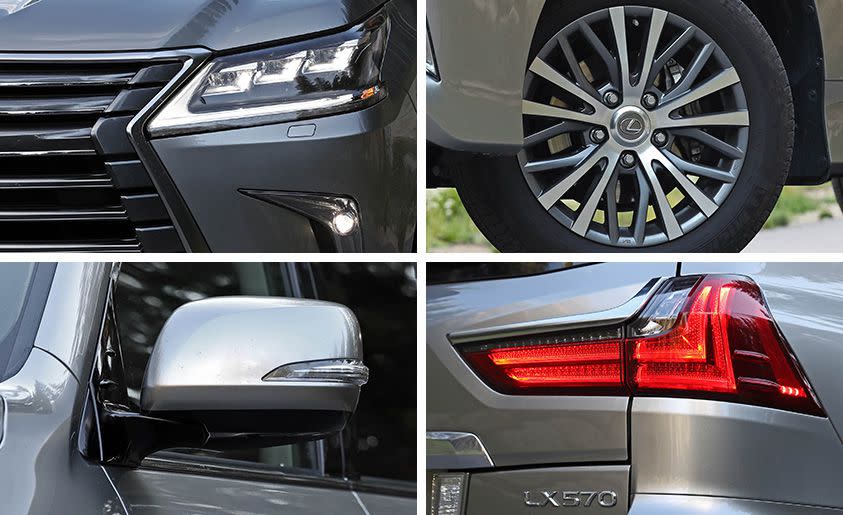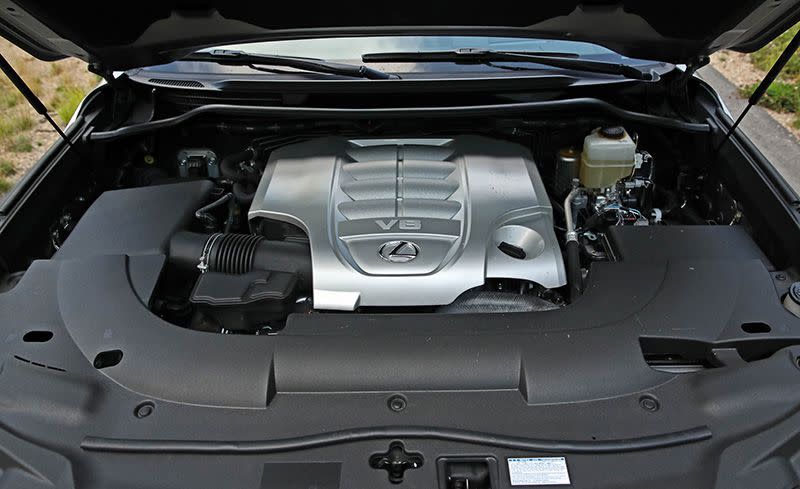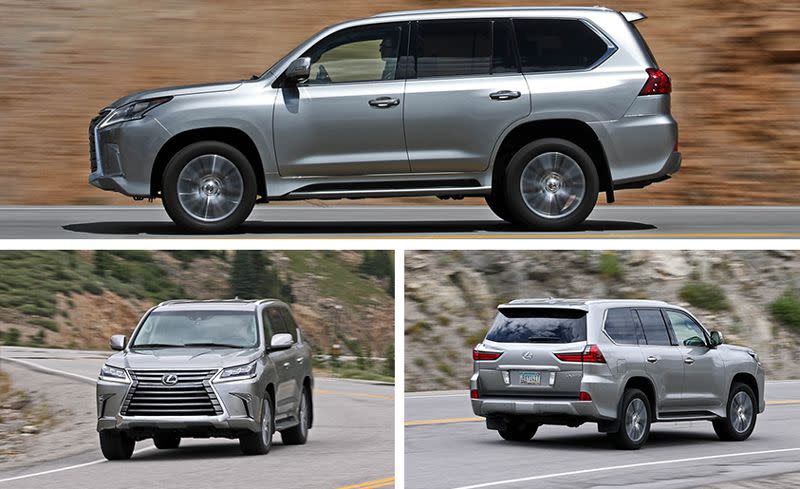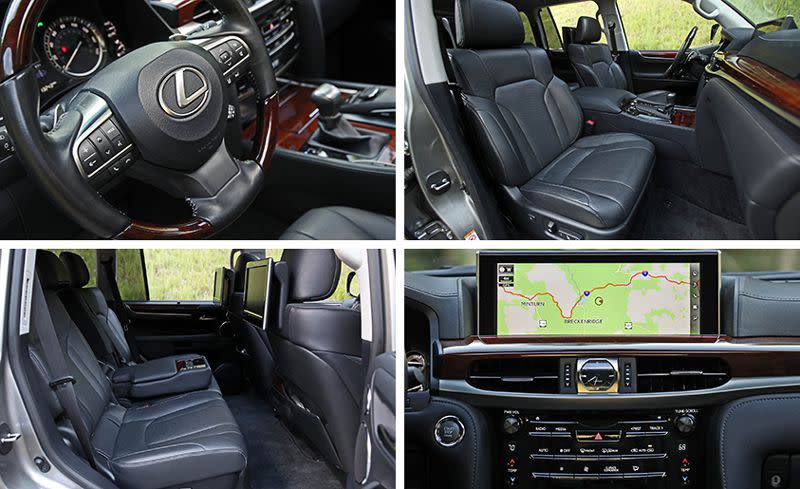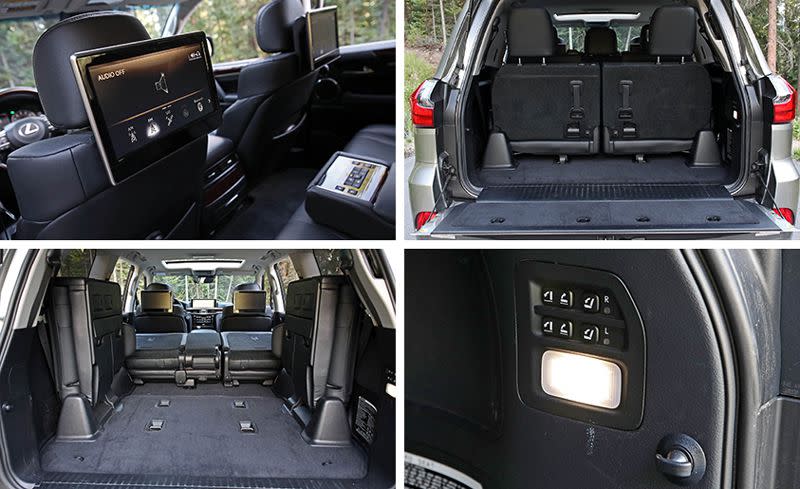2018 Lexus LX570 Tested: Luxurious Adventurer
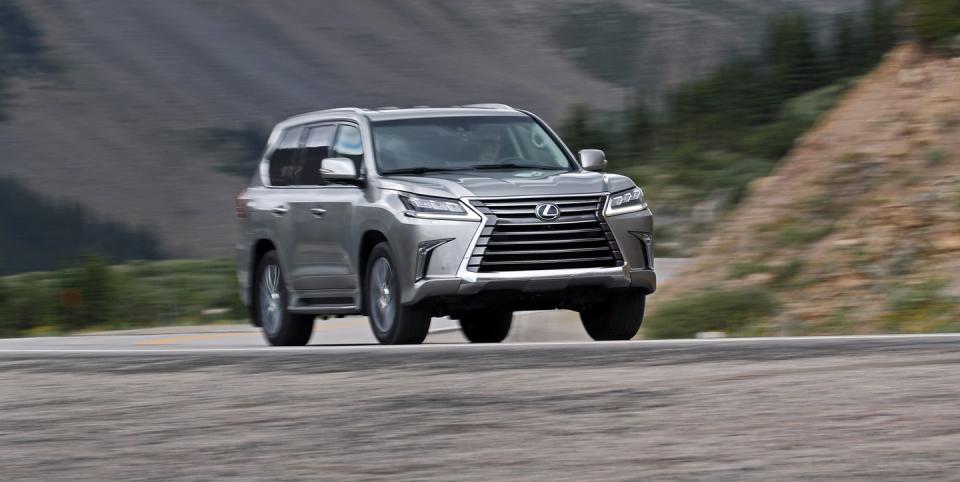
At the center of the Lexus LX570’s dashboard is a 12.3-inch multimedia screen. Its generous size and high-res display offer a stark contrast to the analog clock sitting directly below, tucked between HVAC vents and above a slew of physical buttons and dials. The dash is a blend of old and new, analog and digital, modern and classic, much like the LX570 as a whole.
Although the LX nameplate has been around since only the late 1990s, the vehicle is based on the Toyota Land Cruiser, an off-road icon. The Land Cruiser is Toyota’s most expensive product-by more than $30,000-with a base price of $85,860, while the three-row LX570 starts at $91,825. With a long list of standard luxury features, our test rig did not have a lot of add-ons. Only two items upped the final cost: a $170 cooler in the center console and a second-row dual-screen entertainment system for $2005, bringing the total to an even $94,000.
Reeling in the Years
In car terms, the LX is a dinosaur when considering the age of its underpinnings and powertrain. The current-generation Land Cruiser/LX570 debuted in 2007 for the 2008 model year. Since then, the big Lexus has undergone three facelifts, the most recent of which arrived for 2016, which also is the last time we tested an LX.
Part of that 2016 update included swapping out the previous six-speed automatic transmission for an eight-speed unit. That transmission is paired with a port-injected, naturally aspirated 5.7-liter V-8 that is essentially unchanged from when it was first introduced a decade ago. It makes 383 horsepower and 403 lb-ft of torque, big numbers that are necessary to move the LX570, which crushed our scales to the tune of 6176 pounds (a slightly lighter, two-row version is newly available for 2018).
Tip into the accelerator, and the LX570 takes a deep breath before getting on with it accompanied by a whirring roar. But it’s not slow. On Dunlop Grand Trek PT2A rubber wrapped around 20-inch wheels, the LX steamed to 60 mph in 7.2 seconds. That’s good enough to feel quick, despite significantly trailing the pack of comparable large three-row SUVs. In our testing, the Mercedes-Benz GLS450, GMC Yukon XL Denali, Cadillac Escalade, and Nissan Armada all managed times quicker than 6.0 seconds.
Eight cylinders lugging more than three tons is not a recipe for great fuel economy. Although the model earns EPA estimates of 13 mpg city, 18 mpg highway, and 15 mpg combined, our LX managed just 13 mpg overall and 17 mpg on our 75-mph highway fuel-economy test. And while gas mileage in the teens is typical in this class, it’s also easy to understand why consumers might instead look to a more efficient three-row crossover that isn’t based on truck underpinnings. For those loyal to the Lexus brand, the company recently introduced a new extended-length three-row RX, which also has a hybrid variant that is EPA-rated at 29 mpg combined.
The LX is not made to hurry or hustle; it’s most comfortable cruising in a straight line. The steering is slow and buslike, with a wide on-center dead zone, and it offers zero road feel. The LX requires constant attention to remain on its intended course, which makes driving, especially on the highway, more stressful than it should be. When corners are encountered, the LX reacts clumsily, with plenty of body roll.
Although the LX’s stopping distance from 70 mph is a reasonable 179 feet, braking is not without issue, either. At first slow and squishy, the brake pedal has an inflection point at which the binders grab hard, making modulation difficult.
Loaded Luxe
The interior of the LX mostly lives up to the brand’s luxury billing. The puzzle pieces that make up the dash and the door panels look perfectly placed and sturdily built. Materials are high quality with real metal and pleasantly soft leather, and the layout of the controls is well designed if slightly busy.
The infotainment system’s large screen impresses with its size and crisp resolution. Its split-screen capabilities would seem to be a good idea but include some strange possible configurations. What’s the point of being able to show the music selections on the left and right side at the same time?
Controlling the screen, however, is the biggest issue. The LX uses a floating joystick controller incorporated into the center console. Even worse than using a touchpad, a feature seen in other Lexus vehicles, the controller’s vague movements and haptic feedback results in constantly overshooting the intended selections on the screen. It’s infuriating to use even while parked, and an attention-sucking distraction while in motion.
Off-Road Chops
Behind the controller and the gearshift lever are six buttons, two hefty dials, and two switches that operate the LX’s serious off-road hardware that most crossovers can only dream of. The Lexus is true to its old-school, body-on-frame construction and features permanent four-wheel drive with a locking center differential and a two-speed transfer case. In addition to Comfort, Eco, Normal, Custom, Sport S, and Sport S+ driving modes, the LX offers various terrain modes, including Rock, Rock & Dirt, Mogul, Loose Rock, and Mud & Sand.
The versatility and utility extend to the cabin. Seating is extremely comfortable, with firm but embracing cushioning. Space in the three-person second-row bench is ample, while the three-seat third row is tight but usable.
The garage-door-size upper liftgate of the LX slowly rises up to reveal a small cargo hold, while the lower section drops down like a tailgate. A side-panel-mounted button folds the seatbacks of the rearmost bench, which is split 50/50, while a separate switch tucks the folded units up against the sides of the cargo area. It’s an unusual setup, and one that’s not ideal, as the folded seats still are not completely out of the way and significantly cut into the width of the cargo area.
The Lexus LX570 is versatile and offers an overall solid package, but its negatives will require buyers to make some sacrifices. It’s luxurious and rugged, but it wears a near six-digit price tag, has some obvious Toyota parts, and isn’t the best-in-class at anything. In its current form, then, the model’s aging basic design puts it toward the back of the pack among its richly priced peers.
You Might Also Like

 Yahoo Autos
Yahoo Autos 